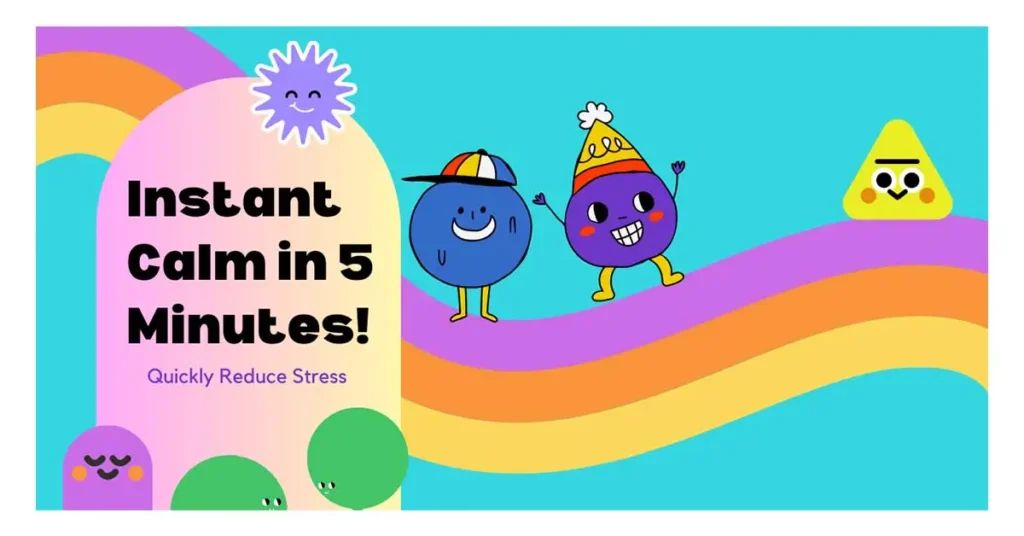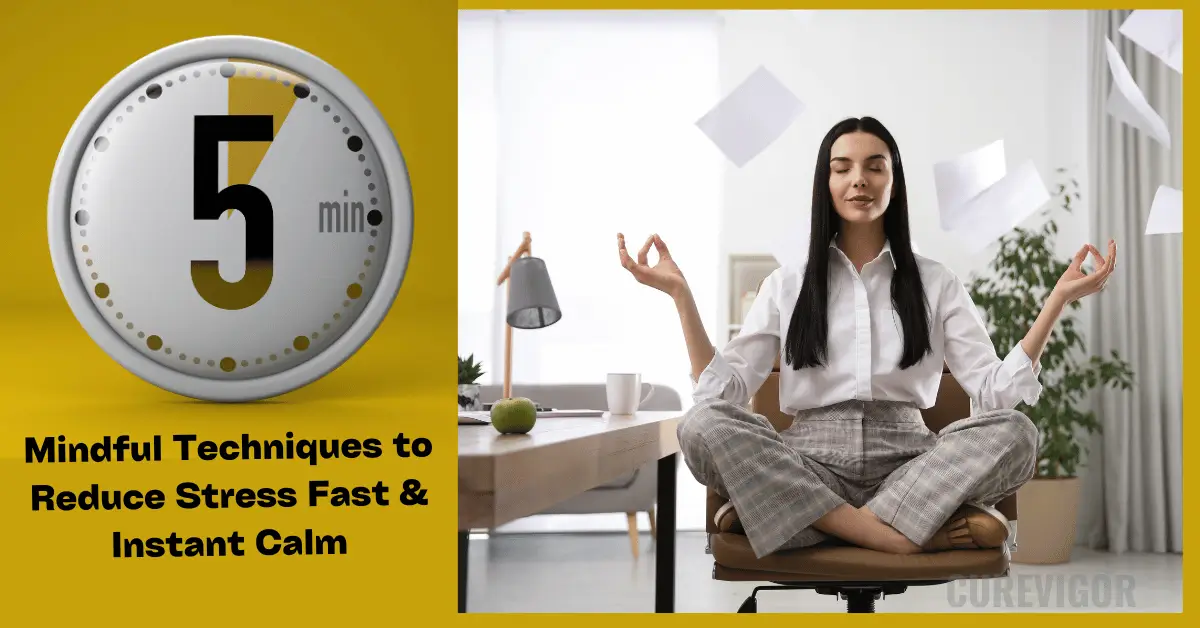Achieve instant calm with five quick mindfulness techniques for stress relief! In just five minutes, you can relax your mind and body—anytime, anywhere.
Thank you for reading this post, don't forget to subscribe!Mindful Wellbeing: How to Reduce Stress in 5 Minutes
In today’s world, stress seems to find us wherever we go—at work, at home, and even in our quiet moments. But what if you could achieve instant calm in just five minutes?
Imagine having the power to melt away stress, center yourself, and reset your day, no matter where you are.
Whether you’re rushing to meet deadlines, managing family chaos, or simply feeling overwhelmed, these quick and easy mindful techniques can bring you back to peace.
Dive in to discover simple, effective ways to reduce stress anytime, anywhere—because five minutes is all it takes to reclaim your calm.

5-Minute Instant Calm Techniques
Here are five simple, powerful techniques for reducing stress in just five minutes. They will help you return to your day with a calm and focused mind.
1. Deep Breathing Exercises to Get Instant Calm

Deep breathing exercises are an effective way to reduce self-centeredness and promote mental relaxation. Locate a cozy spot to sit first. If it helps you concentrate, close your eyes.
Take a deep breath through your nose and gently fill your lungs. To give the air time to settle, hold your breath for a few seconds. Next, release whatever tension you may be experiencing by softly exhaling through your mouth.
Do this five times, with each breath helping lower your heart rate and instantly calming your thoughts.
This simple exercise reduces stress and enhances focus, preparing you to handle any challenge with a clear mind.
- Activity: Try “4-7-8 Breathing.” Breathe in via your nose for four seconds, hold it for seven, and then gently release it through your mouth for eight.
- Duration: Repeat for 5 minutes. This technique promotes relaxation by slowing the heart rate and calming the nervous system.
2. Progressive Muscle Relaxation (PMR)
Progressive Muscle Relaxation (PMR) works by sequentially tensing and relaxing your muscles, releasing tension held in your body.
Start with your toes: tense them for about five seconds, feeling the muscle contraction, and then release. Notice how your muscles feel lighter as you release the tension.
Gradually move upwards to your calves, thighs, abdomen, and shoulders, tensing and relaxing each group. Focus on the feeling of each release to soothe your body and mind.
This technique is easy to do anywhere, whether sitting at your desk or lying down, and it creates a gentle yet effective release from physical and mental stress.
- Activity: Start from your feet and work your way upward, tensing each muscle group (feet, calves, thighs, abdomen, shoulders, and arms) for 5 seconds, then relax for 10 seconds.
- Duration: Spend about 30 seconds per muscle group for 5 minutes. This practice releases physical tension, eases stress, and enhances body awareness.
3. Visualization for Peace

Visualization lets you transport yourself to a calm place whenever stress overwhelms you. To begin, close your eyes and take a few deep breaths. Imagine a serene place—a beach with gentle waves, a quiet forest, or a cozy room where you feel safe.
Let yourself fully immerse yourself in this place, engaging all your senses. Hear the sounds, feel the textures, smell the air, and taste any pleasant flavors if that’s part of your image.
Visualization draws your attention away from stressors, helping you replace negative thoughts with peaceful, comforting ones. This technique can renew your calm and control in just a few minutes.
- Activity: Picture yourself in a calming setting, like a quiet beach. Imagine the details—soft sand, warm sun, gentle waves—engaging as many senses as possible.
- Duration: Spend 5 minutes in this visualization, fully immersing yourself. This technique shifts mental focus, replacing stress with a sense of serenity.
4. Mindfulness Check-In for Instant Calm
A mindfulness check-in grounds you in the present moment and prevents stress from building. Pause and observe your surroundings, tuning into each of your senses.
Notice what you see around you—the colors, shapes, and details. Shift your focus to what you hear, picking up on nearby and distant sounds. Smell the air, feel any textures under your fingers, and even consider if there’s any taste lingering in your mouth.
By mindfully connecting with each sense, you shift your mind away from anxious thoughts and reconnect with the present moment. This practice is the perfect way to reset and achieve instant calm during a busy day.
- Activity: Take 1 minute to focus on each of your five senses. Notice what you see, hear, feel, smell, and taste without judgment.
- Duration: Practice this for 5 minutes total. This sensory grounding anchors you in the present, stopping anxious thoughts and creating instant calm.
5. Quick Journaling for Clarity

Quick journaling lets you clear your mental clutter and make sense of your emotions. Take a notebook or even your phone and write down everything on your mind. Don’t worry about grammar or structure; just let your thoughts flow.
Start by listing the stresses or anxieties you’re facing, along with your feelings about them. You’ll often find that things seem less overwhelming as you write, and your thoughts become more organized.
Even a few sentences can help you gain perspective and let go of negative feelings. This process clarifies your mind, making it easier to move forward with a sense of calm and focus.
- Activity: Set a timer for 5 minutes and write down everything on your mind. List any stresses, thoughts, or feelings without worrying about the organization.
- Duration: Keep writing for the entire 5 minutes. This brief “brain dump” helps clarify thoughts and reduce mental load, giving instant relief from stress.
Quick Bonus Tips for Instant Calm
Beyond the core 5-minute techniques, keep these fast-acting strategies in your mental toolkit:
- Stretch and Move: Gentle stretches or a quick walk can reset your mind and improve blood flow, helping you feel refreshed and calm.
- Focus on a Positive Mantra: Repeat a calming phrase or affirmation to center your thoughts and boost inner peace.
- Limit Screen Time: Take regular breaks from devices to reduce stress and overstimulation; a few tech-free minutes can make a big difference.
- Practice Gratitude: Spend a minute reflecting on something you’re grateful for to shift your focus away from stress and toward positivity.
- Engage in a Creative Activity: Take a moment to draw, doodle, or listen to music to channel stress into a calming, creative outlet.
FAQs About Instant Calm and Stress Relief
Q. How can I control stress in 5 minutes?
You can manage stress in 5 minutes with quick, effective techniques such as deep breathing, progressive muscle relaxation, or visualization. Try slowly inhaling deeply, holding, and exhaling to calm your nervous system.
Even five minutes of focused breathing or mindful awareness can significantly reduce stress, making you feel more grounded and in control.
Q. How to calm your mind in 5 minutes?
To relax your mind in five minutes, begin with a brief mindfulness check-in. Pay attention to what you see, hear, feel, and smell in your immediate environment. As an alternative, close your eyes and visualize a serene scene.
Another easy technique is deep breathing, which involves inhaling for 4 seconds, holding it for 7, and exhaling for 8. These short techniques quickly quiet the mind, bringing immediate instant calm.
Q. What is the fastest way to get instant calm?
The fastest way to get instant calm is to engage your Vagus nerve using a technique like ‘4-7-8 Breathing.’ This involves deep, controlled breaths that signal safety to your nervous system, immediately lowering your heart rate and stress response.
A quick 60-second mindfulness check-in is also an ultra-fast way to ground yourself in the present moment.
Q. How can mindfulness reduce stress?
By keeping you rooted in the here and now and helping you let go of concerns about the past or the future, mindfulness lowers stress.
It promotes nonjudgmental awareness of your thoughts and feelings, enabling you to respond to stress in a composed manner rather than react instinctively.
Frequent mindfulness exercises increase mental resilience, enabling clearer, more controlled management of stressful circumstances.
Conclusion: Make Instant Calm a Daily Habit
You may improve your stress management by incorporating these five-minute tactics into your everyday routine to get instant calm.
You may handle life’s issues with a clearer head and a more peaceful attitude if you set aside only a few minutes each day to cultivate a foundation of serenity.
By making these practices a daily habit, you’re not just reacting to stress—you’re proactively building a mindset ready to face each day’s demands with balance and confidence.
This proactive approach to managing stress improves focus, boosts productivity, and fosters greater contentment in your day-to-day life, providing instant calm whenever you need it most.
Read more Health and Balance articles.
You might like:

